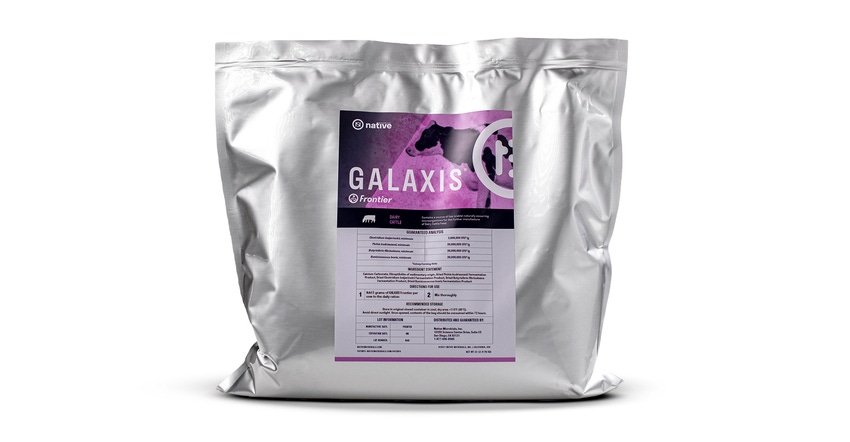
Clostridium beijerinckii. Pichia kudriavzevii. Unless you’re a microbiome scientist, these microbes are not exactly household names.
But these living organisms live in the machine that drives many decisions on dairy farms: the cows’ rumen. Native Microbials, a company based in San Diego, harnesses microbes with the goal of improving cow production and efficiency. It is just about to launch its second product that it believes will boost milk production even more.
The company released its first product for cows last year, Galaxis 1.0, with the active microbes Clostridium beijerinckii and Pichia kudriavzevii. The product comes in 10-kilogram mylar bags that can be mixed right into a total mixed ration at just 5 grams per head per day — or 0.01 pound per head per day — enough to feed 2,000 cows.
Now, Native Microbials is preparing to roll out its second product, Galaxis Frontier, which has four active microbes — Ruminococcus bovis, Butyrivibrio fibrisolvens, Clostridium beijerinckii and Pichia kudriavzevii — and can boost milk production and feed efficiency even more.
Finding microbes
Lisa Marotz, a microbiome scientist with Native Microbials, has only been in the dairy industry for a year, but she has been studying microbial ecosystems for much longer. In the past 20 years, she says, there has been a boom in next-generation sequencing to better understand the role of microbials in living things, including animals.
"The dairy industry is an awesome place to do that because cows, ruminants, unlike other animals, need their microbiomes," Marotz says. “We know that the rumen microbiome is completely essential not just to her health, but also to her ability to produce milk.”
Native Microbials was founded six years ago by a group of microbiologists whose first goal was to inventory the types of microbes living in the cow rumen. Marotz says the researchers collected 6,000 samples from cows around the world, including here in the U.S. and in Mexico.
“They wanted to see the type of diversity out there,” she says. “We just tried to learn as much as we could about what the rumen microbiome looks like under different circumstances.”
What those researchers found was a common core microbiome that was the same for cows eating pasture in Vermont or munching on high-grain diets in Mexico.
It was from this core microbiome, Marotz says, that additional analyses were done to find microbes most associated with cow health and high production. These “keystone organisms,” she says, were identified and, using anerobic chambers, isolated.
Making a feed additive
The challenge to cultivating microbes is that they are living organisms that must be preserved and are highly sensitive to oxygen.
Marotz says the company developed a licensed technology that could freeze-dry the microbes with a protective layer. The end product is a powder feed additive that is packed in mylar bags that can be mixed into a TMR. But it is only stable in a TMR for 24 hours.
The 10-kilogram bags are designed to feed 2,000 cows at 5 grams per head per day. For a smaller, 200-head dairy, one bag would last a little over a week.
Marotz says the company uses micro-tracer audits on farms to ensure the right amount gets mixed into TMRs. She says the company is developing smaller-sized bags to be used on small dairies.
Does it work?
The big question is whether the feed additive — at a current cost of 10 cents per head per day — provides enough bang for the buck.
In a study done by California-based Dairy Experts, a contract research organization, the results were not great for Galaxis 1.0, but did show promise for Galaxis Frontier.
The additives were fed to 90 lactating Holsteins 20 to 40 days in milk. The results showed that, on average, cows fed Galaxis Frontier produced 4 kilograms — 8.8 pounds — more milk than cows that were not fed the additive. They also produced more butterfat and protein, and saw better feed efficiency.
But cows fed Galaxis 1.0 saw an only slight increase in production, butterfat and protein. In fact, it wasn’t even statistically significant from the control group, according to a report by Dairy Experts.
Only 20 farms, mostly larger farms, are using the product right now, Marotz says. These dairies are mostly in California and Colorado with trials ongoing in Arizona and an academic trial at Penn State. Since each state regulates animal feed additives, Galaxis has not yet been approved in several high-profile dairy states, she says, including New York and Texas.
Still, Marotz says the product could be a good option for dairy producers wanting a natural alternative to boost milk production.
"We bring value to the farmer. It's really cool, new technology, and it is all natural,” she says. "We think this is a safer way to improve efficiency in the dairy cow. These are native rumen microbes that can't be found anywhere else. You can't compare them to existing direct-fed microbials. It comes really from the heart of science.”
For more information on the Galaxis feed additive and Native Microbials, visit nativemicrobials.com.
About the Author(s)
You May Also Like






